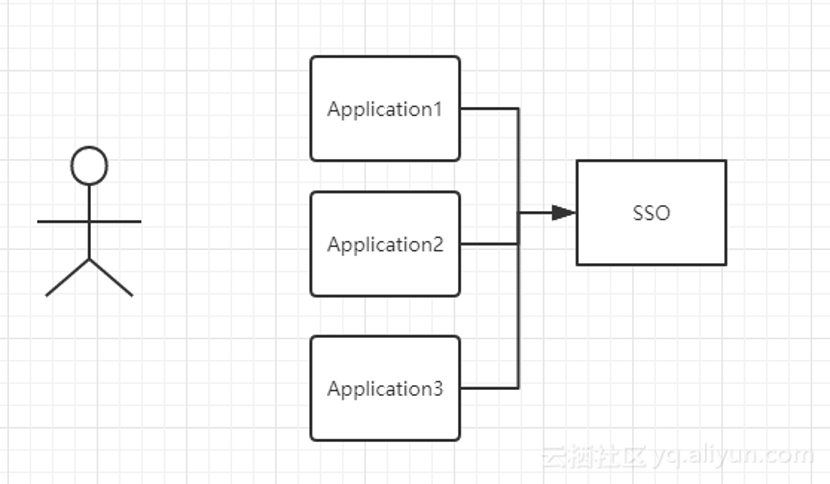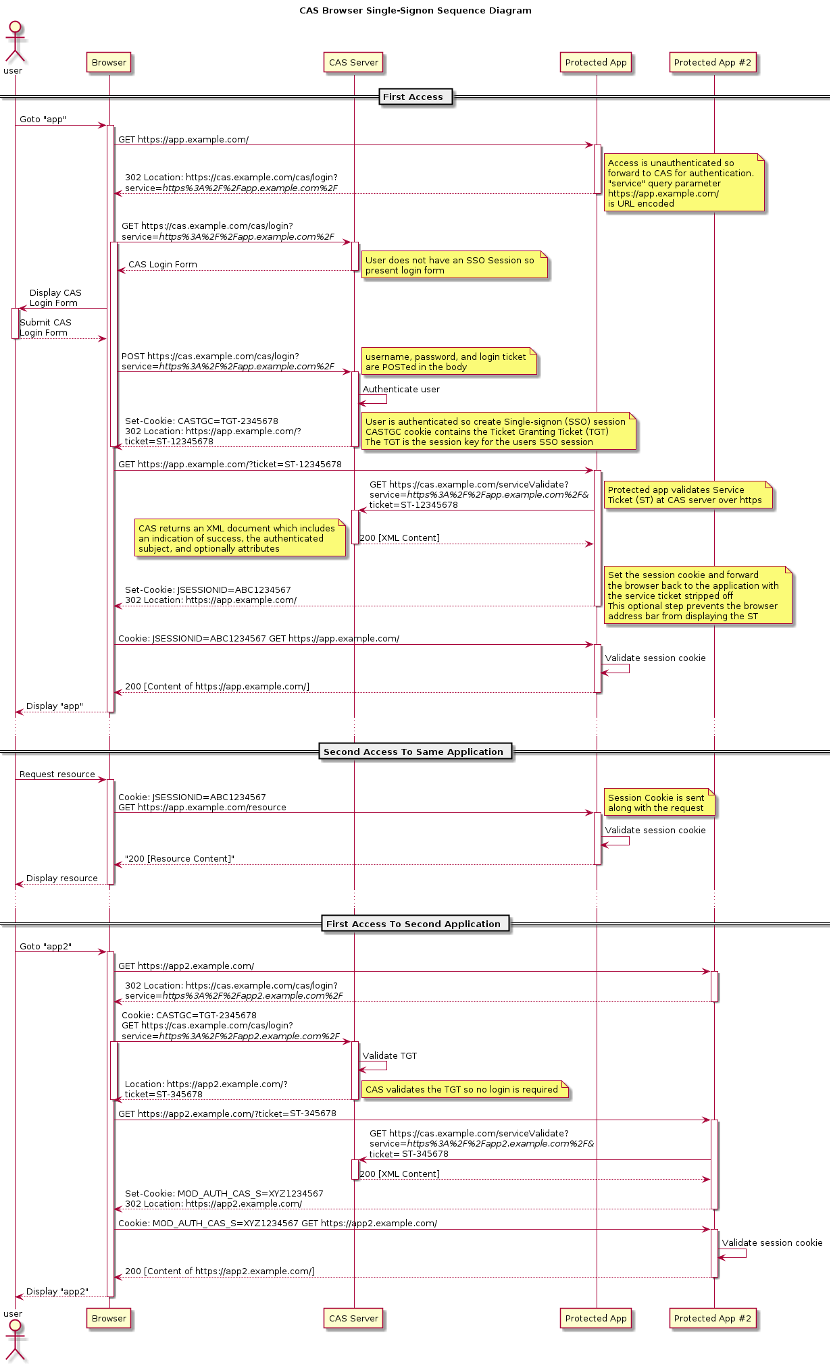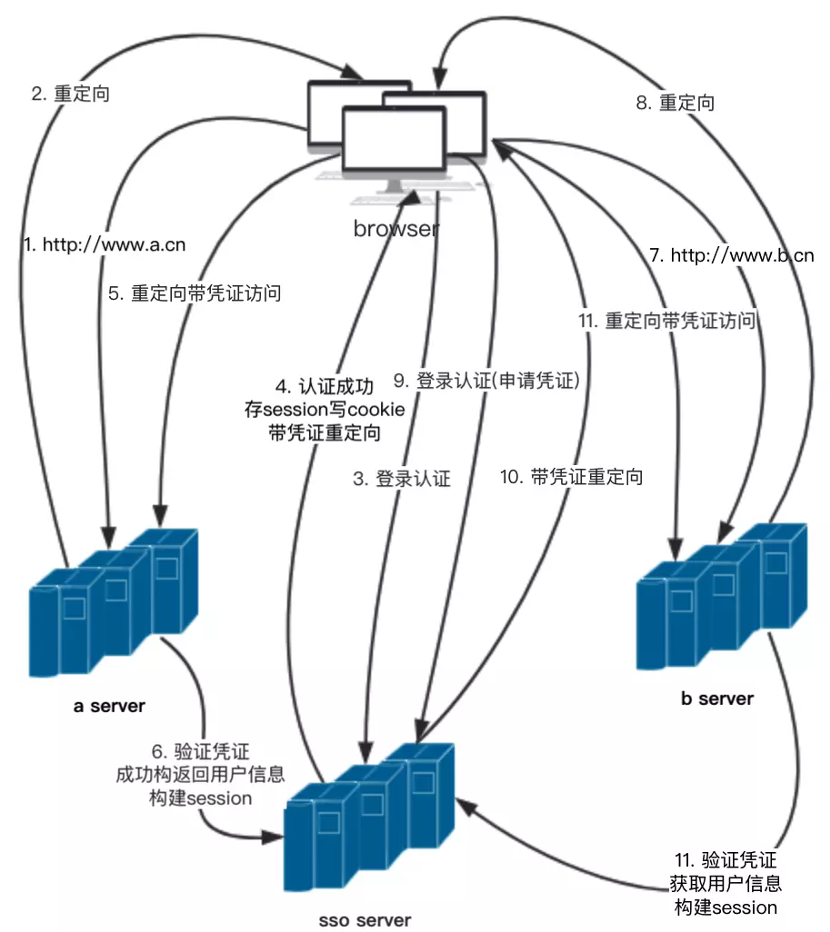Cas接入
SSO介绍
背景
在企业发展初期,企业使用的系统很少,通常一个或者两个,每个系统都有自己的登录模块,运营人员每天用自己的账号登录,很方便。 但随着企业的发展,用到的系统随之增多,运营人员在操作不同的系统时,需要多次登录,而且每个系统的账号都不一样,这对于运营人员来说,很不方便。于是,就想到是不是可以在一个系统登录,其他系统就不用登录了呢?这就是单点登录要解决的问题。
定义
单点登录英文全称Single Sign On,简称就是SSO。它的解释是:在多个应用系统中,只需要登录一次,就可以访问其他相互信任的应用系统.
 如图所示,图中有4个系统,分别是Application1、Application2、Application3、和SSO。Application1、Application2、Application3没有登录模块,只负责业务模块,而SSO只有登录模块,没有其他的业务模块,当Application1、Application2、Application3需要登录时,将跳到SSO系统,SSO系统完成登录,其他的应用系统也就随之登录了。这完全符合我们对单点登录(SSO)的定义。
如图所示,图中有4个系统,分别是Application1、Application2、Application3、和SSO。Application1、Application2、Application3没有登录模块,只负责业务模块,而SSO只有登录模块,没有其他的业务模块,当Application1、Application2、Application3需要登录时,将跳到SSO系统,SSO系统完成登录,其他的应用系统也就随之登录了。这完全符合我们对单点登录(SSO)的定义。
同域下的单点登录是运用了Cookie同域共享的特性,但这不是真正的单点登录。
因为如果是不同域呢?不同域之间Cookie是不共享的,怎么办?
这里我们就要说一说CAS了,CAS流程才是单点登录正宗的解决方案。
CAS介绍
CAS ( Central Authentication Service ) 是 Yale 大学发起的一个企业级的、开源的项目,旨在为 Web 应用系统提供一种可靠的单点登录解决方法(属于 Web SSO )。
从结构上看,CAS系统包含两个部分:CAS Server 和CAS Client
CAS Server 负责对用户的认证工作;需要独立部署,有官方的详细教程.
CAS Client 负责处理对客户端受保护资源的访问请求; 与受保护的客户端应用部署在一起,以Filter方式保护 Web 应用的受保护资源,过滤从客户端过来的每一个 Web请求.
CAS Client 没有官方的Node版本,需要自己实现.
所以今天我就来谈谈Node与 CAS Client集成的实现.
CAS理论
CAS 协议定义了一组术语,一组票据,一组接口。
术语:
Service: 需要使用单点登录的各个服务。CAS Server: 中心服务器,也是SSO中负责单点登录的服务器。CAS Client: 各个service的后台。
接口:
- /login:登录接口,用于登录到中心服务器。
- /logout:登出接口,用于从中心服务器登出。
- /validate:用于验证用户是否登录中心服务器。
- /serviceValidate:用于让各个 service 验证是否登录中心服务器。
票据:
TGT:Ticket Grangting Ticket TGT是CAS为用户签发的登录票据,拥有了TGT,用户就可以正名用户在CAS成功登录过。TGT封装了Cookie值对应的用户信息。当HTTP请求到来时,CAS以此Cookie值(TGC)为key查询缓存中有无TGT,如果有的话,则相信用户已登录过。
TGC: Ticket Granting Cookie CAS Server生成TGT放入自己的Session中,而TGC就是这个Session的唯一标识(SessionId),以Cookie形式放到浏览器端,是CAS Server用来明确用户身份的凭证。
ST: Service Ticket ST是CAS用户签发的访问某一service的票据。用户访问service时,service发现用户没有ST,则要求用户去CAS获取S。用户想CAS发出获取ST的请求,CAS发现用户有TGT,则签发一个ST,返回给用户。用户拿着ST去访问service,service拿ST去CAS验证,验证通过后,允许用户访问资源。
CAS流程
官方流程图
 官方文档:https://apereo.github.io/cas/6.0.x/protocol/CAS-Protocol.html
官方文档:https://apereo.github.io/cas/6.0.x/protocol/CAS-Protocol.html
流程图

流程图解析
1、 用户访问产品a,域名是www.a.cn. 2. 由于用户没有携带在 a 服务器上登录的 a cookie,所以 a 服务器返回 http 重定向,重定向的 url 是 SSO 服务器的地址,同时 url 的 query 中通过参数指明登录成功后,回跳到 a 页面。重定向的url 形如 sso.dxy.cn/login?service=https%3A%2F%2Fwww.a.cn。 3. 由于用户没有携带在 SSO 服务器上登录的 TGC(看上面,票据之一),所以 SSO 服务器判断用户未登录,给用户显示统一登录界面。用户在 SSO 的页面上进行登录操作。 4. 登录成功后,SSO 服务器构建用户在 SSO 登录的 TGT(又一个票据),同时返回一个 http 重定向。这里注意:重定向地址为之前写在 query 里的 a 页面。重定向地址的 query 中包含 sso 服务器派发的 ST。重定向的 http response 中包含写 cookie 的 header。这个 cookie 代表用户在 SSO 中的登录状态,它的值就是 TGC。 5. 浏览器重定向到产品 a。此时重定向的 url 中携带着 SSO 服务器生成的 ST。 6. 根据 ST,a 服务器向 SSO 服务器发送请求,SSO 服务器验证票据的有效性。验证成功后,a 服务器知道用户已经在 sso 登录了,于是 a 服务器构建用户登录 session,记为 a session。并将 cookie 写入浏览器。注意,此处的 cookie 和 session 保存的是用户在 a 服务器的登录状态,和 CAS 无关。 7. 之后用户访问产品 b,域名是 www.b.cn。 8. 由于用户没有携带在 b 服务器上登录的 b cookie,所以 b 服务器返回 http 重定向,重定向的 url 是 SSO 服务器的地址,去询问用户在 SSO 中的登录状态。 9. 浏览器重定向到 SSO。注意,第 4 步中已经向浏览器写入了携带 TGC 的cookie,所以此时 SSO 服务器可以拿到,根据 TGC 去查找 TGT,如果找到,就判断用户已经在 sso 登录过了。 10. SSO 服务器返回一个重定向,重定向携带 ST。注意,这里的 ST 和第4步中的 ST 是不一样的,事实上,每次生成的 ST 都是不一样的。 11. 浏览器带 ST 重定向到 b 服务器,和第 5 步一样。 12. b 服务器根据票据向 SSO 服务器发送请求,票据验证通过后,b 服务器知道用户已经在 sso 登录了,于是生成 b session,向浏览器写入 b cookie。
实践演示
发车了......
CAS 域名配置
- cas server 域名 https://cas.ucloudadmin.com
- cas client 域名 www.clienta.com www.clientb.com
host 配置
1#CAS
2127.0.0.1 clienta.com
3127.0.0.1 clientb.com
nginx 配置
1server {
2listen 80;
3server_name clienta.com;
4
5location / {
6proxy_set_header Host $host;
7proxy_set_header X-Real-IP $remote_addr;
8proxy_set_header X-Forwarded-For $proxy_add_x_forwarded_for;
9proxy_pass http://127.0.0.1:1024;
10}
11}
12
13server {
14listen 80;
15server_name clientb.com;
16
17location / {
18proxy_set_header Host $host;
19proxy_set_header X-Real-IP $remote_addr;
20proxy_set_header X-Forwarded-For $proxy_add_x_forwarded_for;
21proxy_pass http://127.0.0.1:1025;
22}
23}
使用
启动 cas client 服务
1cd clienta
2npm start // or node app.js
3cd clientb
4npm start // or node app.js
clienta 代码
1// app.js
2const express = require('express')
3const app = express()
4const session = require('express-session');
5const cas = require('connect-cas');
6const URL = require('url');
7const querystring = require("querystring");
8
9const casServer = 'cas.ucloudadmin.com'
10const casClient = 'clienta.com'
11
12// var _defaults = {
13// protocol: 'https',
14// host: undefined,
15// hostname: undefined, // ex. google
16// port: 443,
17// gateway: false, // set to true only if you wish to do authentication instead of authorization
18// paths: {
19// validate: '/cas/validate', // not implemented
20// serviceValidate: '/cas/serviceValidate', // CAS 2.0
21// proxyValidate: '/cas/proxyValidate', // not implemented
22// proxy: '/cas/proxy', // not implemented
23// login: '/cas/login',
24// logout: '/cas/logout'
25// }
26// }
27
28/*
29var myOptions = {
30 protocol: 'https',
31 host: 'cas.ucloudadmin.com',
32 hostname: 'ucloud', // ex. google
33 port: 443,
34 gateway: false, // set to true only if you wish to do authentication instead of authorization
35 paths: {
36 validate: '/cas/validate', // not implemented
37 serviceValidate: '/cas/serviceValidate', // CAS 2.0
38 proxyValidate: '/cas/proxyValidate', // not implemented
39 proxy: '/cas/proxy', // not implemented
40 login: '/cas/login',
41 logout: '/cas/logout'
42 }
43}
44cas.configure(myOptions);
45*/
46
47// Your CAS server's hostname
48cas.configure({
49 protocol: 'https',
50 host: casServer,
51});
52console.log(cas.configure());
53
54app.use(express.json());
55app.use(express.urlencoded({ extended: true }))
56
57app.use(
58 session({
59 secret: 'clienta',
60 name: 'SESSIONID',
61 resave: true,
62 saveUninitialized: true,
63 cookie: { maxAge: 24 * 60 * 60 * 1000, httpOnly: true }, //过期时间 24 小时
64 }),
65);
66
67// 用户验证
68app.use(function (req, res, next) {
69 console.log('req.url', req.url);
70 let path = req.url.split('?')[0]
71 // 跳过登录请求
72 if (path === '/login') {
73 next()
74 } else {
75 if (req.session.cas && req.session.cas.user) {
76 next()
77 } else {
78 return res.send(`<h2>this is clientA</h2><p>You are not logged in. <a href=/login?service=http://${casClient}${req.url}>Log in now.</a><p>`);
79 // 自动跳转登录
80 // return res.redirect(`/login?service=http://${casClient}${req.url}`);
81 }
82 }
83});
84
85app.get('/', function (req, res) {
86 console.log('get /', req.url)
87 return res.send('<h2>this is clienta</h2><p>You are logged in. Your username is ' + req.session.cas.user + '. <a href="/logout">Log Out</a></p>');
88});
89
90app.get('/login', cas.serviceValidate(), cas.authenticate(), function (req, res) {
91 console.log('/login', req.url)
92 let arg = URL.parse(req.url).query;
93 let params = querystring.parse(arg);
94 // console.log("params-service " + params.service);
95 // 重定向到初始请求地址
96 return res.redirect(params.service || '/');
97});
98
99app.get('/logout', function (req, res) {
100 if (!req.session) {
101 return res.redirect('/');
102 }
103 // Forget our own login session
104 if (req.session.destroy) {
105 req.session.destroy();
106 } else {
107 // Cookie-based sessions have no destroy()
108 req.session = null;
109 }
110 // Send the user to the official campus-wide logout URL
111 var options = cas.configure();
112 options.pathname = options.paths.logout;
113 return res.redirect(URL.format(options));
114});
115
116
117// 业务接口路由
118app.get('/api', function (req, res) {
119 return res.send('<h2>this is clientA API Page</h2><p>You are logged in. Your username is ' + req.session.cas.user);
120});
121app.get('/api/userInfo', function (req, res) {
122 res.json({ retCode: '1', data: req.session.cas });
123});
124
125// ......
126
127app.listen(1024, () => {
128 console.log('示例程序正在监听 1024 端口!')
129});
登录 cas client 前台
浏览器打开 clientA clientB
跳转 cas server 验证 / 登录